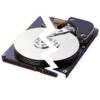visits
5785
votes
12
votes++Vote positively this post :)
+34
votes--Vote negatively this post :(
-22
Partitions of the hard disk. Are good or bad?

In first place I want clarify that I'm not talking about the new disk of solid state (SSD), but of the magnetic disk drives of ever(HD).
The structure of a hard disk is the following: A hard disk is formed by a stack of platters of ferromagnetic material. If we cut one of this platters in slices as it was a pizza, we get the sectors, one in each face of the slice of pizza. If we cut making a circumference we get a track for each face of the platter, and if we cut all the platters together making a circumference we have, literally, a cylinder. In the next image you can see it more easily:

Each time that we read a data from de hard disk a logical direction is given to it that translate in a physical direction, that is no more than a cylinder, track and sector where have to go to search the data, as if was the direction of a flat where we need the street, the number of the doorway and the floor to locate it.
What happens when a data is read?
For every platter there are a head on the upper part and down. From de physical direction of the data (cylinder, sector and track), all the heads are moved together to the corresponding cylinder. This is the operation temporally more slow of execute and is called search time.
Then, the disk have to wait that the sector pass below of the head that is on the track that have to read. This is the latency time and is a lot of more fast than the search time, because the disk is rotating constantly at high speed (between 5.000 and 10.000 rpm).
Next, it wait to read the data. This timeout is called transfer time that is a lot of more fast than the latency time. Simply consist in that the magnetic field produced by the disk, when pass below of the head, generates an electrical current in it.
When we store information in a hard disk, at the beginning, the files are going put one after another, but with the use, of moving, deleting and adding information, we can have files that are stored in different parts of the disk. This is called external fragmentation. The fragmentation slows the reading of the files, principally, due to the search time, because each part will be in different track and probably very far, forcing the hard disk to displace the head. While if the hard disk wouldn't be fragmented the file would be in the same track or in continuous tracks, and the head wouldn't have to move, or do it only a little.
What happens when we have only a partition for all the disk? The file can be fragmented along all the tracks of the disk, increasing considerably the search time at the time of read the complete file. But, if we make partitions in the disk, the file only can be fragmented inside of the partition where it is, because it will can't be stored beyond the cylinder where finish its partition. In this way the head doesn't need make displacements along all the disk to read the complete file, reducing so the time that need to read the files. For this reason is very recommended create partitions.
The ones that argue that make partitions of the disk is bad, usually they say that increase the latency time and the search time is not affected, this is totally false. Their error is in how think that the partitions are created. They think that are made cutting the side of a sector as if the disk was a sausage pizza, when really, if the partition begins in a physical direction given by its cylinder, track and sector, is cut first by the cylinder, next by the track and finally by the sector. In the following image you can see this with a graphical example:

At the left you have represented how think the people that the partitions are make and, at the right, how it is make really. In fact, in some installations of GNU/Linux allows round the partition to the cylinder to avoid cut the last track by the half. Even in old versions, when GNU/Linux, due to its difficulty, still wasn't accessible to most of the users, the installer ask you what was the cylinder from where you want cut the disk instead of ask the capacity that you want in the partition.
What is the ideal number of partitions?
Depends of the kind of file system and the capacity of the disk although as minimum must have 3, one for the virtual memory paging file (as all distros of GNU/Linux does by default), other for the operating system and the software and, finally, other to our personal files. From here if we have more partitions it will be better, all depends how you want organize your information in the disk.
About to the SDD make partitions doesn't make that the disk will go faster nor slower, because the read/write speed is always the same, independently of where would be the data because we can access to it directly. Although we must do partitions simply to organize better the information and avoid the lost of valuable data when we reinstall the operating system.